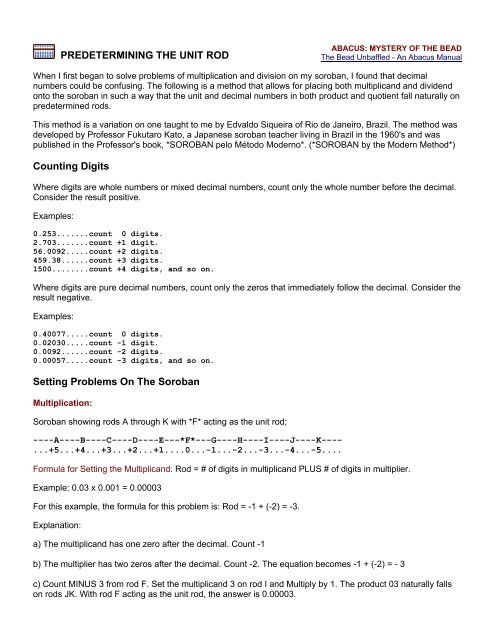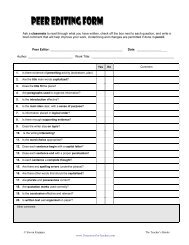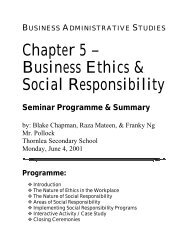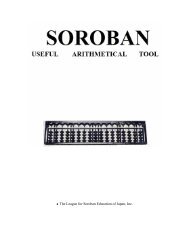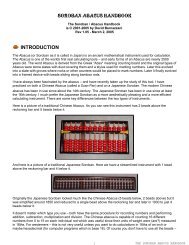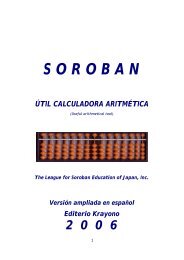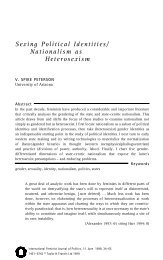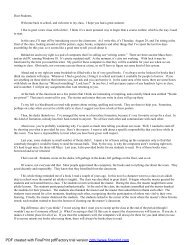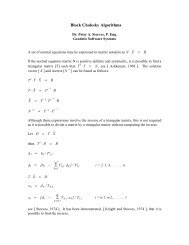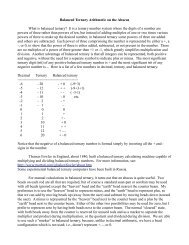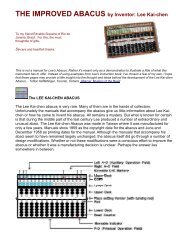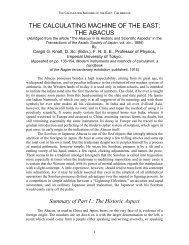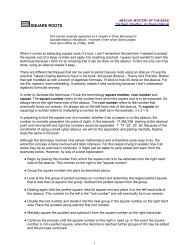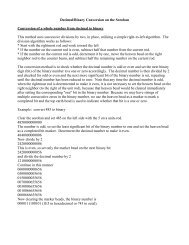Abacus and Decimals
Abacus and Decimals
Abacus and Decimals
You also want an ePaper? Increase the reach of your titles
YUMPU automatically turns print PDFs into web optimized ePapers that Google loves.
PREDETERMINING THE UNIT ROD<br />
ABACUS: MYSTERY OF THE BEAD<br />
The Bead Unbaffled - An <strong>Abacus</strong> Manual<br />
When I first began to solve problems of multiplication <strong>and</strong> division on my soroban, I found that decimal<br />
numbers could be confusing. The following is a method that allows for placing both multiplic<strong>and</strong> <strong>and</strong> dividend<br />
onto the soroban in such a way that the unit <strong>and</strong> decimal numbers in both product <strong>and</strong> quotient fall naturally on<br />
predetermined rods.<br />
This method is a variation on one taught to me by Edvaldo Siqueira of Rio de Janeiro, Brazil. The method was<br />
developed by Professor Fukutaro Kato, a Japanese soroban teacher living in Brazil in the 1960's <strong>and</strong> was<br />
published in the Professor's book, *SOROBAN pelo Método Moderno*. (*SOROBAN by the Modern Method*)<br />
Counting Digits<br />
Where digits are whole numbers or mixed decimal numbers, count only the whole number before the decimal.<br />
Consider the result positive.<br />
Examples:<br />
0.253.......count 0 digits.<br />
2.703.......count +1 digit.<br />
56.0092.....count +2 digits.<br />
459.38......count +3 digits.<br />
1500........count +4 digits, <strong>and</strong> so on.<br />
Where digits are pure decimal numbers, count only the zeros that immediately follow the decimal. Consider the<br />
result negative.<br />
Examples:<br />
0.40077.....count 0 digits.<br />
0.02030.....count -1 digit.<br />
0.0092......count -2 digits.<br />
0.00057.....count -3 digits, <strong>and</strong> so on.<br />
Setting Problems On The Soroban<br />
Multiplication:<br />
Soroban showing rods A through K with *F* acting as the unit rod;<br />
----A----B----C----D----E---*F*---G----H----I----J----K----<br />
...+5...+4...+3...+2...+1....0...-1...-2...-3...-4...-5....<br />
Formula for Setting the Multiplic<strong>and</strong>: Rod = # of digits in multiplic<strong>and</strong> PLUS # of digits in multiplier.<br />
Example: 0.03 x 0.001 = 0.00003<br />
For this example, the formula for this problem is: Rod = -1 + (-2) = -3.<br />
Explanation:<br />
a) The multiplic<strong>and</strong> has one zero after the decimal. Count -1<br />
b) The multiplier has two zeros after the decimal. Count -2. The equation becomes -1 + (-2) = - 3<br />
c) Count MINUS 3 from rod F. Set the multiplic<strong>and</strong> 3 on rod I <strong>and</strong> Multiply by 1. The product 03 naturally falls<br />
on rods JK. With rod F acting as the unit rod, the answer is 0.00003.
Further examples for multiplication<br />
30 x 8............R = 2 + 1 = 3<br />
2 x 3.14..........R = 1 + 1 = 2<br />
12 x 0.75.........R = 2 + 0 = 2<br />
0.97 x 0.1........R = 0 + 0 = 0<br />
0.5 x 0.004.......R = 0 + (-2) = -2<br />
Division:<br />
Soroban showing rods A through K with *F* acting as the unit rod;<br />
----A----B----C----D----E---*F*---G----H----I----J----K----<br />
...+5...+4...+3...+2...+1....0...-1...-2...-3...-4...-5....<br />
Formula for Setting the Dividend: Rod = # of digits in dividend MINUS (# of digits in divisor + 2)<br />
Example: 0.0032 ÷ 0.00016 = 20<br />
For this example, the formula becomes: Rod = -2 - (-3 +2) = - 1.<br />
Explanation:<br />
a) The dividend has two zeros after the decimal. Count -2.<br />
b) The divisor has three zeros after the decimal. Count MINUS (-3 + 2) = +1.*<br />
Putting it all together the equation becomes -2 + 1 = -1.<br />
c) Count MINUS 1 from rod F. Set the dividend 32 on rods GH <strong>and</strong> divide by 16. Following "Rule I" for placing<br />
the first quotient number, the answer 2 naturally falls on rods E. With rod F acting as the unit rod, the answer<br />
shows 20.<br />
Further examples for division<br />
365 ÷ 0.5.........R = 3 - (0 + 2) = 1<br />
0.02 ÷ 0.4........R = -1 - (0 + 2) = -3<br />
0.09 ÷ 0.003......R = -1 - (-2 + 2) = -1<br />
64 ÷ 32...........R = 2 - (2 + 2)= -2<br />
640 ÷ 32..........R = 3 - (2 + 2) = -1<br />
0.004 ÷ 0.0002....R = -2 - (-3 + 2)= -1<br />
For more on "Rule I", please see Quotient<br />
Rules.<br />
* Two negatives multiplied together equal a positive. ex. - (-3 + 2) = +1<br />
Back to Multiplication<br />
Back to Division<br />
<strong>Abacus</strong>: Mystery of the Bead<br />
© 2004, 2005 by Totton Heffelfinger & Gary Flom<br />
An alternative method for:<br />
Locating the Decimal


